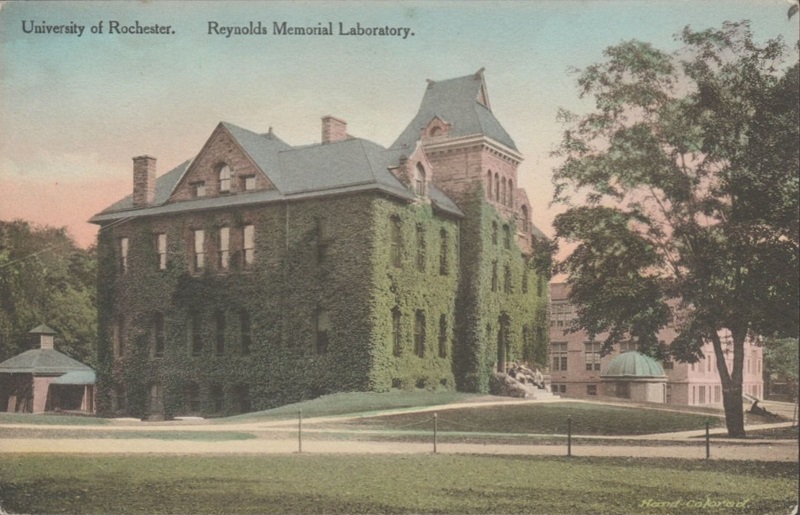
| Prince Street Campus | Reynolds Laboratory |
 |
| Reynolds Memorial Laboratory |
The Reynolds
Memorial Laboratory was, given in 1886 by Mortimer F. Reynolds as a
memorial to his brother, William A. Reynolds, a former trustee of the
University. The building was enlarged and refurnished in 1915.
The building
was sold in 1955 to Carhart Service, Inc. as a photo laboratory and
was torn down in 1964.
References
1872 William
Abelard Reynolds (1810-1872), grave in Mt. Hope Cemetery
1884 Semi-centennial
History of the City of Rochester, by William Farley Peck
Pages 692-695: William Abelard Reynolds and Mortimer F. Reynolds.
1886 Interpres,
by Class of 1887
Page 81-82: Engraving and description
of the Reynolds Memorial Laboratory.
1886 "Description of new laboratory given by M. F. Reynolds," Rochester Union and Advertiser, 0ctober 19, 1886, Page 3-1
1886 "Contract
Awarded," Democrat and Chronicle, September 30, 1886, Page
6.
The contract for steam heating in the Reynolds Memorial Building at the
university was yesterday awarded to Barr & Creelman of this city.
1887 The
Campus, January 22, 1887, Page 70.
The new Reynolds Laboratory, the foundation of which was laid a year ago
this fall, was opened on Monday last.
1892 Mortimer Fabricus Reynolds (1814-1892), grave in Mt. Hope Cemetery
1904 Chemistry Laboratory, from Library of Congress
1910 The
University of Rochester : buildings and grounds
Pages 11-12: Reynolds Laboratory
1925 The
National Cyclopedia of American Biography, by J. T. White
Pages 79-80: Mortimer Fabricius Reynolds, banker.
1927 Rochester,
the making of a university, by Jesse Leonard Rosenberger, with
an introduction by President Rush Rhees.
Page 216: The year 1887 witnessed the completion of the Reynolds
Memorial Laboratory prior to the annual meeting of the board of trustees
in June. The building was erected by Mortimer F. Reynolds, a banker in
Rochester, in memory of his brother, William A. Reynolds, who had been a
trustee of the university. Constructed of brown stone, the building was
fireproof, seventy-one feet long, sixty-five feet wide ,and three stories
high. It cost $25,000. The board expressed the warmest admiration for the
personal care and attention which the donor had devoted to the
construction of the building, the thoroughness of its construction, the
chasteness of its architecture, and the admirable facilities afforded by
its interior arrangements.
Page 295: Two years later [1915] the Reynolds Laboratory was
enlarged by building on a new part which yielded 2,280 square feet of
floor space; and the well-lighted basement was refinished so as to provide
two laboratories and two good recitation rooms, as well as coat rooms and
lavatories; besides which the furnishing of the building was completely
modernized, producing a chemical laboratory modern in every particular.
1955 "UR
Sells 2nd Campus Building," Democrat and Chronicle,
September 9, 1955, Page 23.
Reynolds Laboratory sold to Carhart Service Inc.
1964 "Carhart's
Breaks Ground," Democrat and Chronicle, August 12, 1964,
Page 7D.
The present plant, a former University of Rochester science building with
walls nearly three feet thick, will be razed to make room for additional
parking.
1977 History
of the University of Rochester, by Arthur J. May (on-line
version with footnotes)
Chapter 10: The End of an Age
Undoubtedly, the completion in 1887 of a campus structure in which
chemistry would be taught and research conducted quickened the concern of
the U. of R. authorities about science in general. In his annual report of
1881 Anderson told the trustees that a flood of special students in
chemistry made the construction of a chemical laboratory an imperative
necessity, and he carefully studied the plans of a building of that sort
at Vassar. Treasurer Sage and Professor Lattimore spread the gospel among
Rochester citizens of means, and to their great joy Mortimer F. Reynolds,
as mentioned earlier promised to finance a laboratory. Having inherited a
fortune which he enlarged by astute banking and industrial operations,
Reynolds (who, incidentally, was the first white child born in the
frontier village that grew into the city of Rochester) had established a
reputation for civic benevolence by gifts for a superior community library
that bore the family name.
He gave the Reynolds Laboratory to the U. of R. as a memorial to his
deceased brother, William A., sometime a University trustee, and out of
esteem for Lattimore. He hoped that the building might ''stand forever on
the beautiful grounds of the University, an example of architectural
solidity and harmony, an ornament to my native city..." To plan the
layout, Lattimore was released from teaching responsibilities and he
supervised the actual construction and equipment of the building. Oscar
Knebel of Rochester was engaged as architect and contracts for the various
phases of construction were awarded to Rochester firms. Ground was broken
in October of 1885 and in January, 1887, the laboratory was available for
teaching--a far swifter performance than in building Sibley Hall. Costing
slightly less than $25,000, the building was constructed of reddish Albion
stone in what was called Romanesque style with a tower in the center and
dormer windows jutting out from the slate roof. It had two stories, a
basement, an attic, and was heated by steam and was fireproof throughout.
On the ground floor, whose hallway boasted a gay mosaic pavement, were two
large laboratory rooms, a private laboratory for Lattimore, a library, an
office, and a storeroom. Wrought iron stairways led up to lecture and
apparatus rooms and cases of chemical exhibits on the second floor. The
attic was assigned to experiments in photography, then an infant Rochester
industry, while the basement had a workshop as well as a furnace and fuel
storage bins. Regarded as a model structure with ''admirable facilities''
for instruction and scientific investigation, the Reynolds Laboratory was
hailed as a monument to the practical talents of Lattimore "in its
combination of economy of expenditure with perfection of arrangements."
© 2021 Morris A. Pierce